|
29th December
Aberlady
and Port
Seton
We travelled east to Aberlady on Sunday where the weather was to be the
sunniest in Central Scotland. It was cloudy when we stopped off at
Dalkeith Morrisons for breakfast (6/10: disappointing due to cold items
and skimpy bacon) but as we arrived at the Kilspindie Golf Course the
sun was breaking through. It was windy though, as can be seen from the
picture of the club’s fluttering flag. The tide was very low,
but
slowly coming in. A small flock of Oystercatchers flew down the channel
that carries the Peffer Burn to the sea. They’d been disturbed
by
some beachcombers a hundred metres ahead of us. A calling Curlew
followed. John scanned the extensive area of exposed sands and pointed
out a large group of Shelducks
dabbling about a couple of hundred metres away.
|
Oystercatcher |
Curlew |
Shelduck |
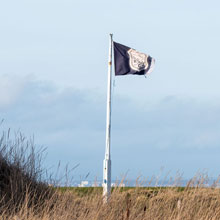 |
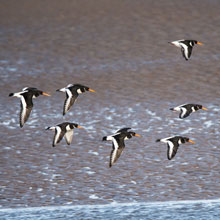 |
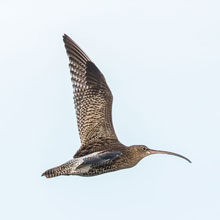 |
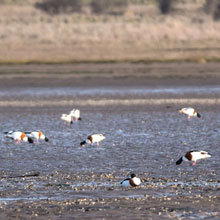 |
We wandered along Kilspindie Point where we came across about fifty
Sanderlings scurrying along the burn waters’ edge. They were
fairly distant when we first saw them but, as they seemed to be getting
closer, we planked ourselves on our stools and waited for them to come
within range for decent shots - which they did. There wasn’t
much
else there so we returned to the car park where John noticed some small
flies, Fannia
Mollissima , were on an information board. A huge
flock of Lapwings went up and we wondered what had put them up.
| Sanderling |
Eider |
Fly - Fannia mollissima |
Lapwing |
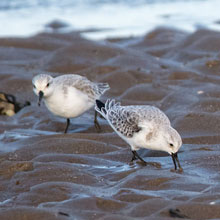 |
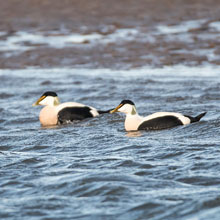 |
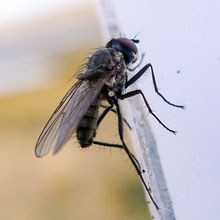 |
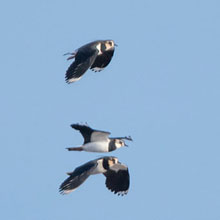 |
We next tried to relocate to the Aberlady Nature Reserve car park, but
it was full, so we parked about 400m west of there on Gullane Road by
Sea Green. It was the nearest point to the wooden bridge across Peffer
Burn where roadside parking was legal. It did, however, allow us to
scan the shoreline from the pavement as we walked to the
bridge.
We saw hundreds of Wigeon in the nice low amber light of the winter
sun. We were delighted to find a single
Little Egret
foraging in the salt marsh near the Reserve car park. It was fairly
mobile and we were lucky enough to see it fly past us, so providing an
excellent photo-opportunity. John noticed a pair of Teal in a pool very close to the pavement.
| Wigeon |
Little Egret |
Female Teal |
Drake Teal |
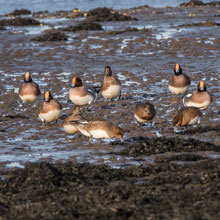 |
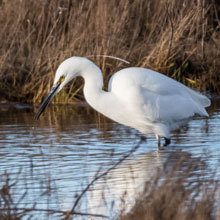 |
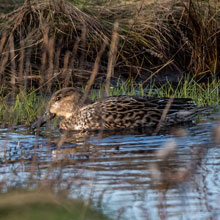 |
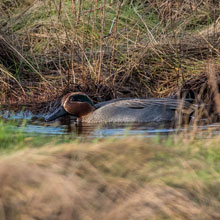 |
Eventually we reached the wooden
bridge over the Peffer Burn. It leads walkers into the Aberlady
Bay Nature Local Nature Reserve but
we decided that there wouldn’t be enough time to do it
justice,
so we made do with a few pictures taken from the bridge. A Curlew was
feeding very close to our stance. It had got hold of what looked like a
type of long worm. On the east side of the bridge a feeding Redshank
and its reflection made a very pretty picture. Next, a pair of Teal swam
closer to us in order to sample the muds just below the bridge.
| Curlew |
Redshank |
Drake Teal |
Female Teal |
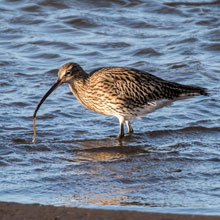 |
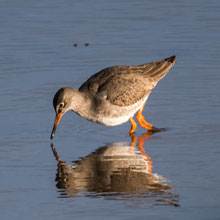 |
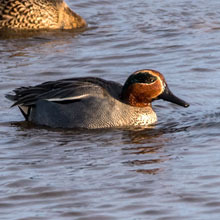 |
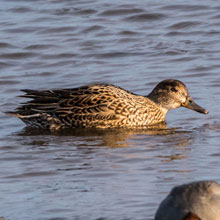 |
On our return journey along Gullane Road we noticed a commotion amongst
the huge flicks of Lapwings. They’d been disturbed by a Peregrine
Falcon.
It was also probably responsible for the disturbance we’d
seen
earlier. I managed a couple of distant record shots of it as it
circulated the inner bay causing widespread panic as it went. Only the
Greylags and Shelducks stayed put. The Falcon had a wee rest on a stump
that was poking through the sands, before settling off in the direction
of Kilspindie.
| Peregrine Falcon |
Greylag Goose |
Shelduck |
Peregrine Falcon |
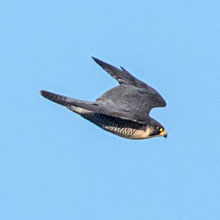 |
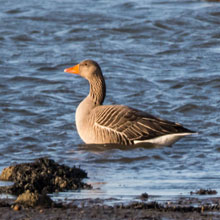 |
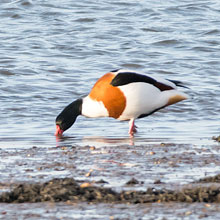 |
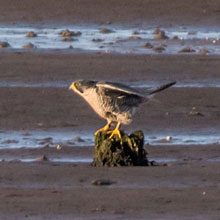 |
The view of Aberlady Bay as seen from Gullane Road:
A large flock of Golden
Plovers
flew in, probably returning from their escape from the Peregrine. They
looked particularly golden in the rich winter sunlight. We also saw a
Curlew and a Herring Gull before we arrived back at the car. We then
had our teas and cream scones on a bench on Sea Green, and watched the
birds gradually fly to better feeding areas as the tide reclaimed the
bay. Although a few of them got their eyes on our scones, a Herring
Gull and a pair of Jackdaws edged in and may have got a few crumbs when
we left but there weren’t many (see “Pictures of
the
Week”, below).
| Golden Plover |
Curlew |
Herring Gull |
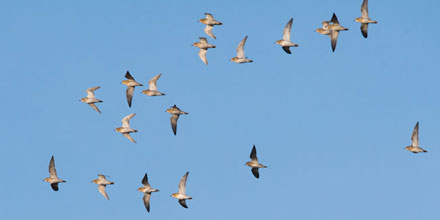 |
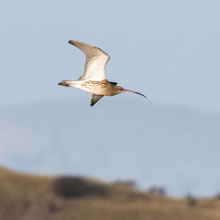 |
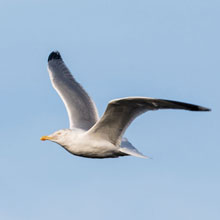 |
On our way home we stopped briefly at Seton Burn, Port Seton, where
birds gather at its mouth at high tide. The orange-tinged sunlight on
the drake Mallards’ plumage was eye catching. I was surprised
to
see a pair of Gadwall
there and even more surprised when a beautiful Fantail
Pigeon flew past. There must be a pigeon loft in the vicinity.
| Mallard |
Gadwall |
Fantail Pigeon |
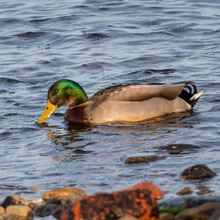 |
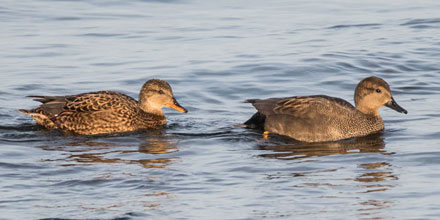 |
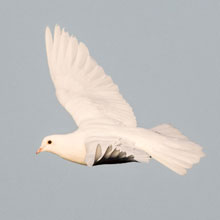 |
Our final stop was at the wee car park that overlooks the rocks at Port
Seton. They are called “Wrecked Craigs” and we
usually find
birds there especially as the tide “pushes” them
nearer the
sea wall. That was the case on Sunday when a Bar - tailed
Godwit
and a Curlew were less than 10m away. They probably couldn’t
see
me as the low sun was behind me. I finished the day with a nice snap of
a lively pair of Black-headed Gulls squabbling over food.
| Bar - tailed Godwit |
Curlew |
Turnstone |
Black - headed Gull |
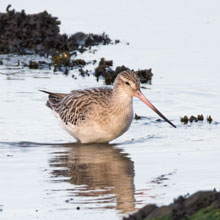 |
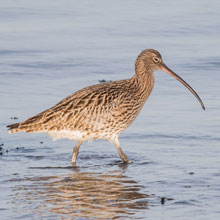 |
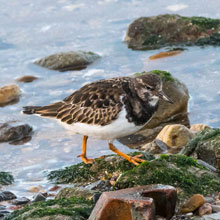 |
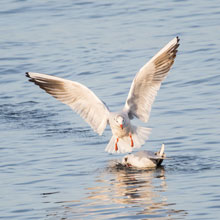 |
We headed home satisfied with another camera-full of sightings, our last
of 2019, in fact, of the decade. Best for me were the Peregrine and
Little Egret. The fly and Sanderling were also a delight. It was very
mild for the time of year, so that too added to our enjoyments. So have
a Guid New Year, lang may yer lum reek, and we’ll see you
next
year.
Pictures of the Week:
| Sanderling |
Little Egret |
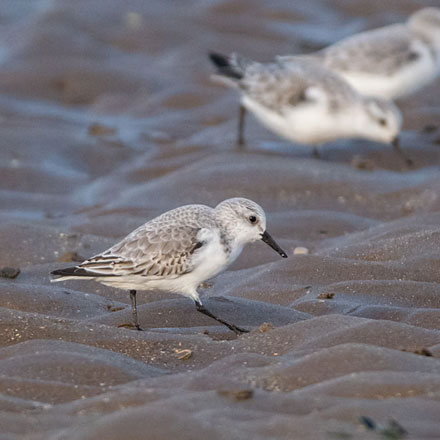 |
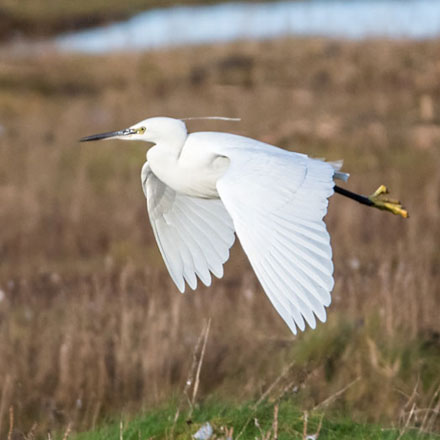 |
| Herring Gull |
Jackdaw |
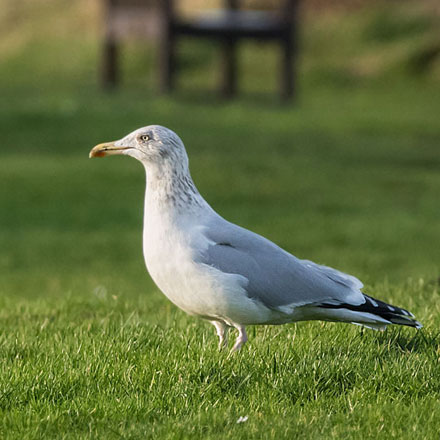 |
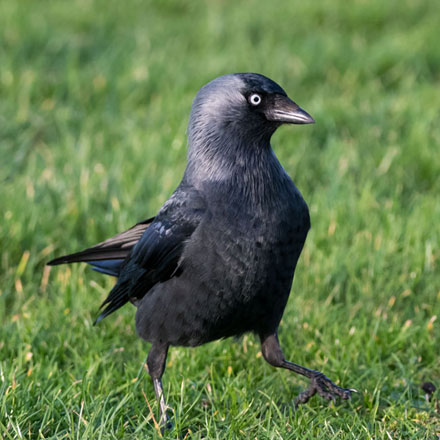 |
22nd December 2019:
Figgate
Park (Map) and Duddingston
Loch
I had been reading all week of Otter sightings at Figgate Park, just to
the east of Edinburgh. It was the
Winter Solstice, the shortest day, the day where the
elevation of the Edinburgh midday sun wouldn’t rise to double
figures.
Good for atmospheric shots when the sun shines, but not so good in
cloudy conditions. We called in at the Morrisons on Portobello Rd,
Edinburgh for a couple of breakfasts (8/10: nice food, but very slow
service) before parking at the gates of Figgate Park (Website).
As we entered the park we passed a small container decorated with very
attractive, brightly-coloured birds, courtesy of
“DacoGraff”. Soon we were walking along a large
wooden
viewing platform at the east side of the pond, where several folk were
scanning the still waters eagerly for Otters
which had been seen within the previous few minutes. Sure enough, they
did appear and gave us a wonderful show as they repeatedly broke
through the water’s surface and dived again. We could follow
their movements by the trail of bubbles left by their exhaled air. One
caught a fish and settled on the island to consume it.
We moved around the pond to see what birds there were. A family of Mute
Swans were gliding towards the west side of the pond where bread was
being tossed into the water. Many Black-headed Gulls were competing
anxiously for every scrap. So too were some Canada Geese and the other
Swans.
| Mute Swan |
Black - headed Gull |
Canada Goose |
Mute Swan |
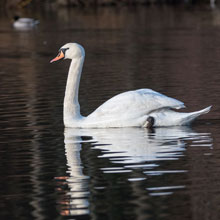 |
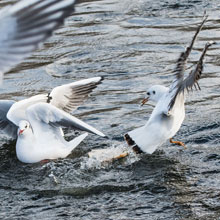 |
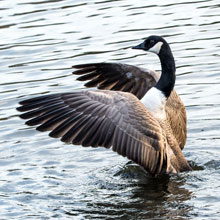 |
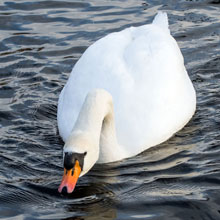 |
A shy Moorhen picked its way around the bank, avoiding the Mallards,
and staying clear of the crabbit Coots. John pointed out an acrobatic
Great Tit feeding in the branches of a nearby tree.
| Moorhen |
Drake Mallard |
Coot |
Great Tit |
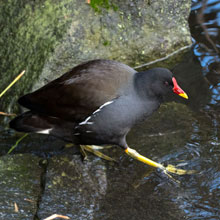 |
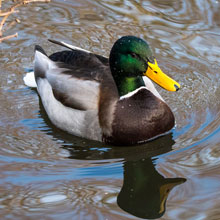 |
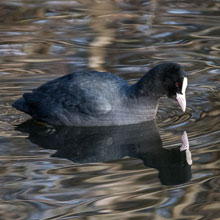 |
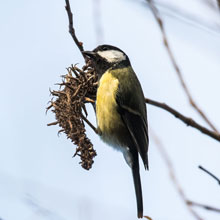 |
We followed the path in the direction of Arthur’s Seat, the
hill
looming to the west. In the trees we saw a flock of Long-tailed Tits and
also a Blue Tit. John spotted a busy Goldcrest
working on the branches of a bush near the footpath. It was always on
the move, weaving about the dense branches, but I did manage a few
decent shots. Near the bush a Jackdaw was searching the grass for
invertebrates. It was completely unaffected by our presence, so used was
it to park users passing without threat. Either that or it was blind.
| Long - tailed Tit |
Blue Tit |
Goldcrest |
Jackdaw |
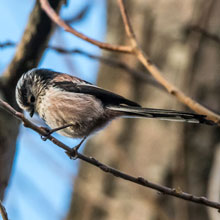 |
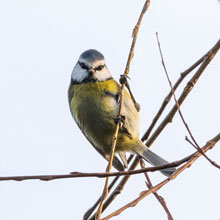 |
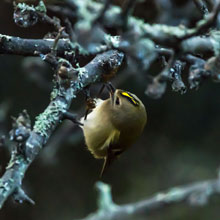 |
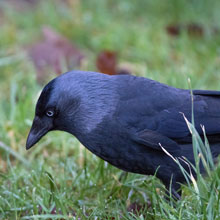 |
I snapped a Woodpigeon perched high in a tree and at the foot of the
tree a Carrion Crow poking around in a puddle, occasionally downing
whatever it had found. Then, below the branches of a group of trees, we
came upon a quartet of nicely-lit, nibbling Grey
Squirrels.
They too seemed used to people as I could get photos from fairly close
in. Unusually, I also got close to a female Blackbird, close enough to
see the details in its brown plumage.
| Wood Pigeon |
Carrion Crow |
Grey Squirrel |
Female Blackbird |
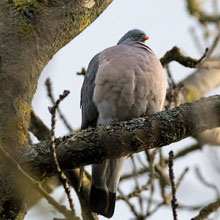 |
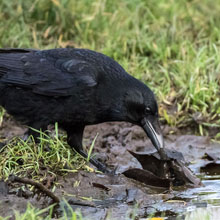 |
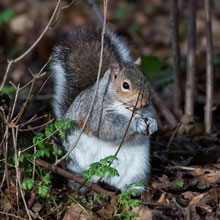 |
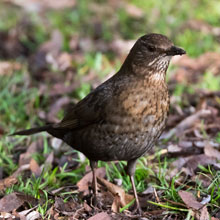 |
Back at the Pond we watched a group of Goosanders diving
for fish. They were perhaps aware the Otters had gone, but were
encouraged by their fishing successes. I took some pictures of a female
with her catch as it downed it speedily to avoid losing it to greedy
onlookers.
Goosander
Looking on was a large cobb Mute Swan, its proud head nicely lit by the
low winter solstice sun. A pair of Canada Geese paddled into view just
as we had a last look along the path. We disturbed a female Bullfinch
that was feeding on seeds of tall vegetation beyond the grassy verge. I
snapped a few shots of it hiding in a nearby bush. We came upon another
one of DacoGraff’s masterpieces on the rear side of a garage
inside the Park. An excellent depiction of a flying Goldfinch.
| Mute Swan |
Canada Goose |
Female Bullfinch |
Daco Graff |
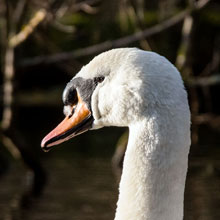 |
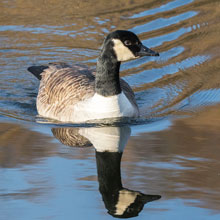 |
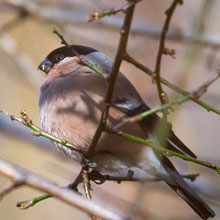 |
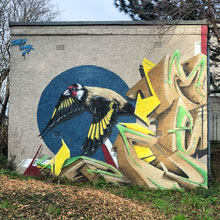 |
We decided to make a quick visit to Duddingston
Loch
which was just a mile to the west. When we got there the sun was
blocked by incoming clouds, but, after re-adjusting my camera settings
we strolled towards the soggy water’s edge. A few Mute Swans
foraging around a stream. On the Loch I got some shots of a very upset
Greylag-Canada Goose hybrid as it took to the air after chasing another
Goose. With the light becoming too low we headed back to the car,
passing our last capture, a fine pair of Mallards.
At the car we had tea and cream scones which we downed with a great
sense of satisfaction. The Otters were the top sighting but I also
enjoyed seeing the fishing Goosanders and the Squirrels. It’s
alway good when you see what you were looking for.
Pictures of the Week:
| Canada x Greylag Goose |
Grey Squirrel |
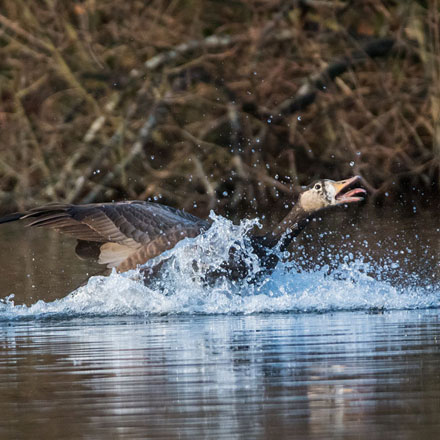 |
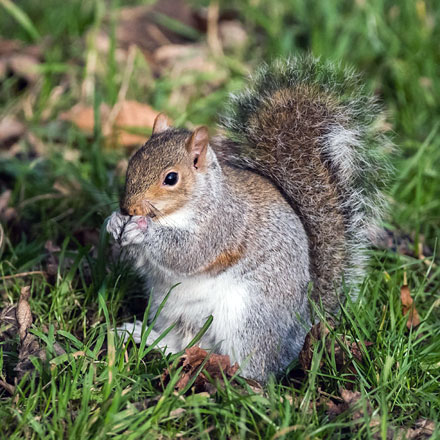 |
Otter
15th
December 2019:
RSPB Loch Leven (Map)
“An improving picture throughout the day for Central
Scotland” the weather girl announced on Sunday morning. I
fancied
a visit to
RSPB
Loch Leven
(Website) (formerly named “Vane Farm”) to see if we could get
some
Pink-footed Goose action. We called into Bathgate Morrisons for a wee
breakfast (9.5/10: excellent) on our way up the M8, before making for
the Queensferry Crossing on the M90 that took us to the turn-off for the
south of bonny Loch Leven. After a dull start it was certainly
brightening up, but we were disappointed to realise that, during our
visit, the low December sun would not peek over Benarty
Hill
(known locally simply as “Benarty”) to the south of
the
reserve. But undeterred, we set forth on our mission, passing first
through the new underpass, which has been built mainly to improve
accessibility for disabled visitors. From the Gillman hide I watched
some Pheasants,
a cock and 2 hens, (see also “Pictures of the
Week”, below)
poking about around a feeder for seed dropped by the many passerines
that were coming and going.
| New Underpass |
Male Pheasant |
Female Pheasant |
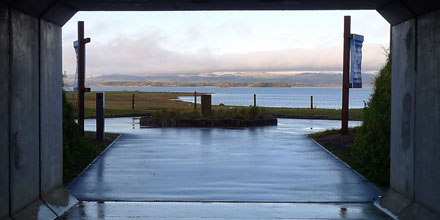 |
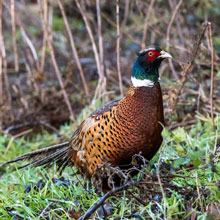 |
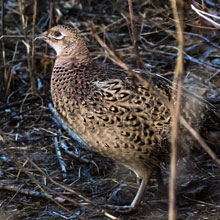 |
The aforesaid passerines were nipping in and away pretty rapidly:
Chaffinches, Coal Tits and a Robin (see also “Pictures of the
Week”, below).
| Chaffinch |
Female Chaffinch |
Coal Tit |
Robin |
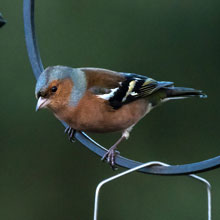 |
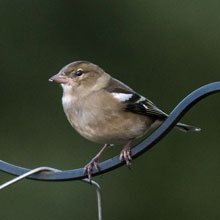 |
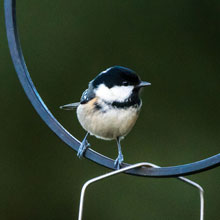 |
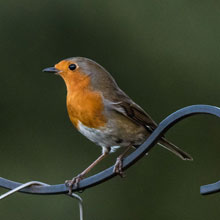 |
A perky wee Blue Tit clung onto the feeder longer as it selected just
the right seed before flying off to the relative safety of the hawthorns.
A Great Tit made a brief appearance. John pointed out a Robin sitting
on a bush directly opposite the hide doorway we were exiting. It was
obviously used to people and was probably hoping we’d chuck
it an
easy meal. It was disappointed. The gliders of the Scottish Gliding
Centre of Scotlandwell were enjoying the sunny but
breezy conditions high above us, while we remained in permanent shadow.
| Blue Tit |
Great Tit |
Robin |
Up, up and away |
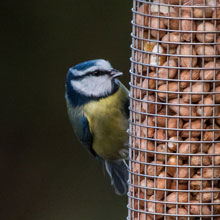 |
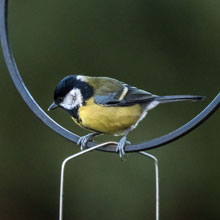 |
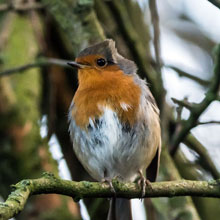 |
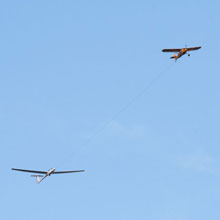 |
On our way to the next hide, the Waterston hide, I snapped some swans
feeding in a pool. There was a family of Whoopers, cobb, pen and two
large cygnets. A couple of Mute Swans were also in the pool , but the
two species didn’t interact. As we entered the Waterston hide
I
spotted a Grey Heron as it peeked over the banks of a grassy hollow.
| Whooper Swan |
Juvenile Whooper Swan |
Mute Swan |
Grey Heron |
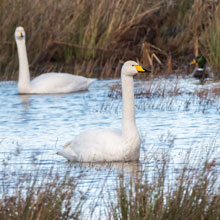 |
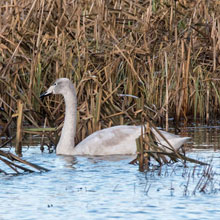 |
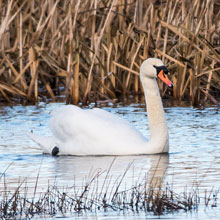 |
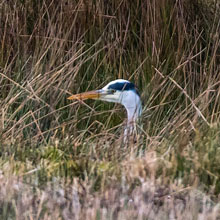 |
From inside the hide we were treated to a close view of four Little
Egrets
feeding and courting. We had seen three of these as they fed
individually about 50m apart, but as we arrived they had flown in and
joined together as a group to forage the the stream that runs in front
of the hide. One of them, presumably a male, was getting very frisky,
displaying his plumage and harassing the other Egrets. He realised he
was onto nothing and flew off leaving the remaining trio advancing
slowly down the stream (see also “Pictures of the
Week”, below).
As we made for the last hide, the Carden hide, I noticed over 500
Crows, probably, over the crest of the ridge to the south. The picture
below shows about 130 of them. From the hide, in the dimming light we
could see and hear Teal and Wigeon dabbling in the large loch. Around
its edges there were masses of Icelandic
Whooper Swans who were also very voluble - as their
name suggests.
| Carrion Crow |
Teal |
Wigeon |
Whooper Swans |
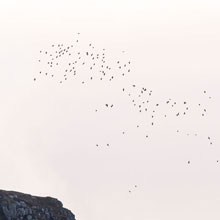 |
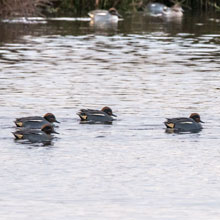 |
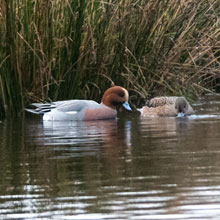 |
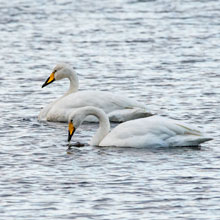 |
There was no sign of Pink-footed
Geese , although there were many Greylags
(also see the panorama below). There were also many Mallards.
Annoyingly, in the distance we could see sheep and cattle standing in
bright sunlight.
| Greylag Goose |
Female Mallard |
Mainly Coos |
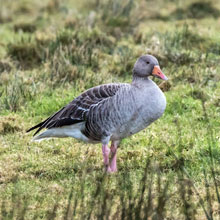 |
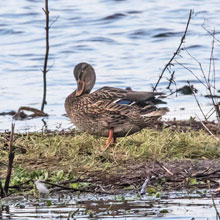 |
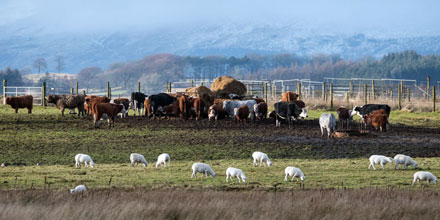 |
Greylags as seen from the Heritage
Trail just along from the Reserve west exit gate
With the light becoming very dim, we headed back to the car. However,
we had a surprise find at a pair of feeders near the car park. We
noticed, despite the gloomy light, a lot of bird activity, so we hung
around a bit to see what would turn up. First to appear were a few
Goldfinches, looking very fine even in the dusk. Next a flock of Long-tailed
Tits
appeared and swarmed around one of the feeders, nine of them feasting
on the fat balls. John drew my attention to one hanging on a branch
just above our heads. It was hanging by its left claws while clutching
seed in its other claw. It was a nice end to the visit.
It had been an enjoyable trip that was not spoiled by being in the
shadow of Benarty. The highlight for me were the Egrets, but
it
was disappointing not to have seen the Pinkfeet - but we did enjoy
looking for them. We ended the day with tea and cream scones. There was
a bit of a surprise inside the scones. Instead of the usual layer of
jam below the cream there was a layer of chocolate paste. I’d
have preferred jam.
Pictures of the Week:
| Pheasant |
Robin |
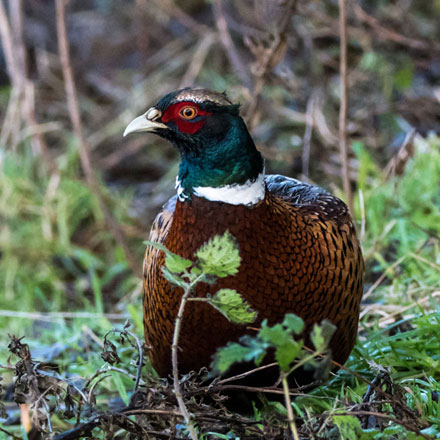 |
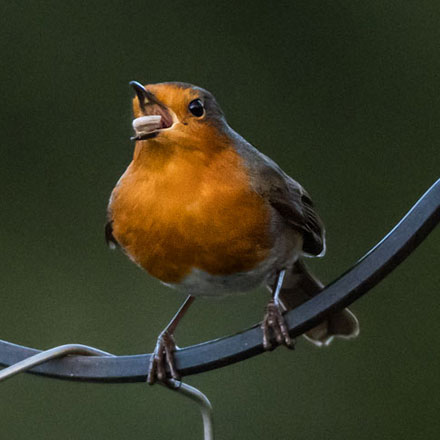 |
| Little
Egret |
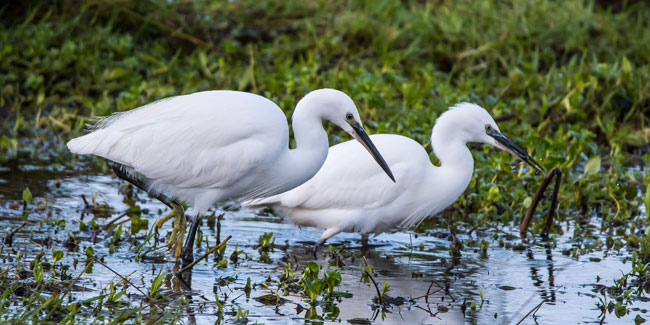 |
8th December 2019: Dunbar
and Port Seton
It was to be wild, wet and windy throughout Central Scotland with just
the possibility that the sun would break out in East Lothian. I opted
then for an exploration of the shores along the coast at the wonderful
town of Dunbar. So after a fine breakfast in Dalkieth
Morrison’s
(9/10) we drove to the east end of Dunbar at the golf course and
started a wind-buffeted trek along the coast. Below is the view of
Dunbar harbour as seen from the golf course.
We were between showers so we had started in good light. A Black headed
gull flew past and into the wind, followed by a female
Red-breasted
Merganser
and a speeding Redshank (also see “Pictures of the
Week”
below). Further out a single drake Eider was bobbing in the choppy
water.
| Black - headed Gull |
Female Red - breasted Merganser |
Redshank |
Eider |
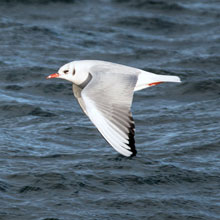 |
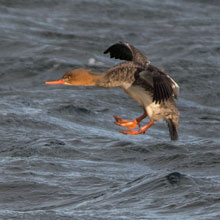 |
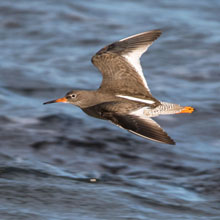 |
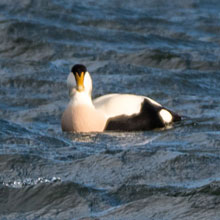 |
A flock of Starlings flew up from the rocks where they were feeding on
seaweed, before settling on a dry boulder (see “Pictures of
the
Week” below). Also on the seaweed were a few Turnstones
probing
for invertebrates. Further out on a more exposed rock I believe I saw
some Purple
Sandpipers sheltering
from the wind. I got a nice couple of flight shots of Curlews trying to
find some acceptable feeding locations on the busy rockscape.
| Starling |
Turnstone |
Purple Sandpiper |
Curlew |
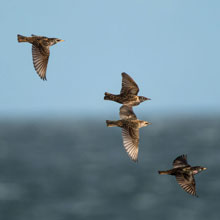 |
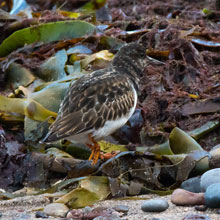 |
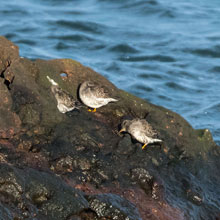 |
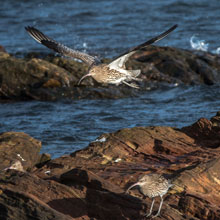 |
Seven nicely-lit Redshanks stood on a low, sheltered ledge, and 6
metres behind them a flock of Grey
Plovers
were also lined up on the rocks, with more flying in. Like all of the
seaside sites we have visited, there were lots of Oystercatchers filling
the air with their strangely comforting racket.
| Redshank |
Grey Plover |
Oystercatcher |
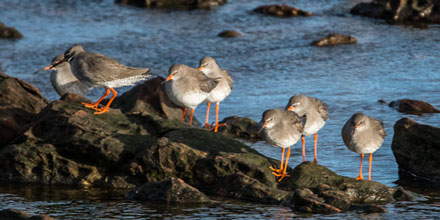 |
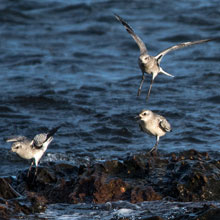 |
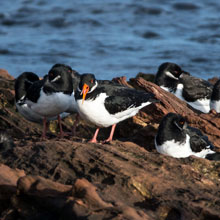 |
The dark clouds were rolling in, so we hastily escaped a soaking by
legging it back to the car. I then drove the short distance along the
“low” roads to the Harbour and waited until the sun
reappeared. The harbour waters were filled with Eider. I managed
pictures of a strikingly marked juvenile male, a female and a drake
(see “Pictures of the Week” below). As well as
Eiders there
were, of course, plenty of Herring
Gulls .
I photographed a typical 2nd year Herring Gull swimming with the Eider.
As we moved back to the car I noticed a bold adult Herring Gull
standing on the deck of one of the fishing boats moored at the harbour.
| Juvenile Eider |
Female Eider |
2nd Cycle Herring Gull |
Herring Gull |
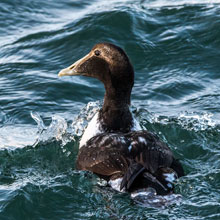 |
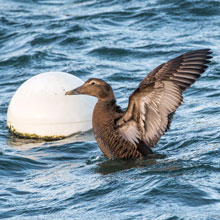 |
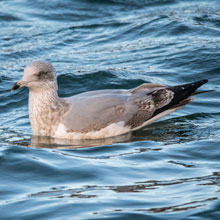 |
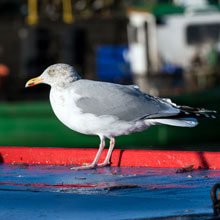 |
Below is a view of a Rainbow as seen from Dunbar Battery :
Our final location in Dunbar was Winterfield Park. At the cliffs the wind
was disturbingly strong. I nearly lost my camera’s rain cover
when it was caught by the wind and propelled towards the cliff edge.
However John managed to retrieve it centimetres from the edge, impaled
on a young Buckthorn bush. After a quick refit I snapped a shot of a
sizeable flock of Feral Pigeons gathered on a great rock 50m from the
cliff. John noticed a couple of the Pigeons were white - probably
hybrids. Looking out along the Firth of Forth we could see the
Bass Rock
appearing rather less white than a few months ago, the nesting Gannets
and their young having left weeks before. Given the winds strength we
were surprised to see birds flying past the cliffs. Oystercatchers,
though, didn’t seem to be too bothered by the gale, and
neither
were the Curlews (see “Pictures of the Week” below).
| Feral Pigeon |
Bass Rock |
Oystercatcher |
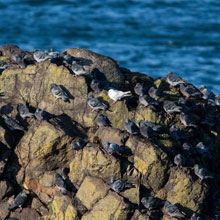 |
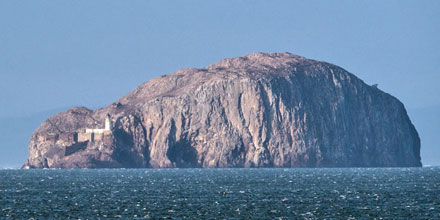 |
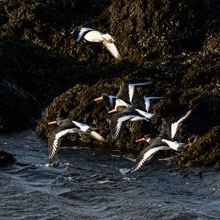 |
We still had a bit of time left before heading back home so we called
into Port Seton. We were lucky with the light as the clouds cleared for
long enough to catch some pictures of a Bar-tailed Godwit probing the
sands for invertebrates. Just below the promenade a Rock Pipit flew onto
a seaweed pile and allowed me to grab a few shots before darting off.
John spotted a couple of pairs of Red-breasted Mergansers 100m away
frolicking offshore. They were pretty animated, probably courting since
the females flew off followed by the drakes.
| Bar - tailed Godwit |
Rock Pipit |
Red - breasted Merganser |
1st Cycle Herring Gull |
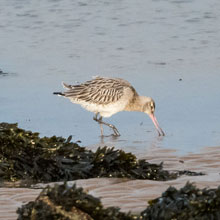 |
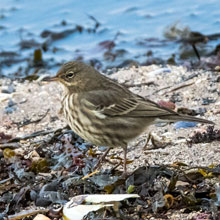 |
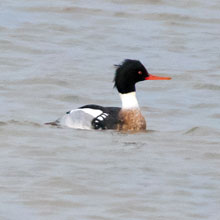 |
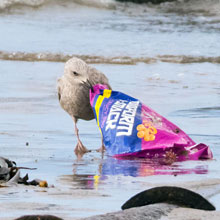 |
Pictures of the Week:
| Redshank |
Starling |
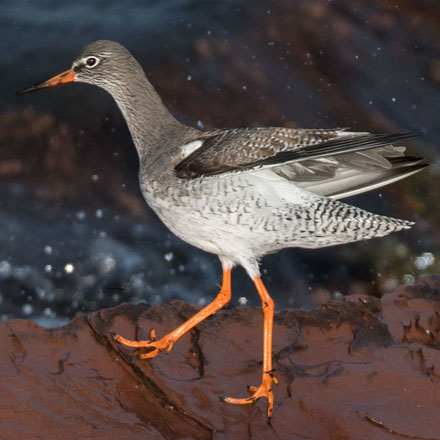 |
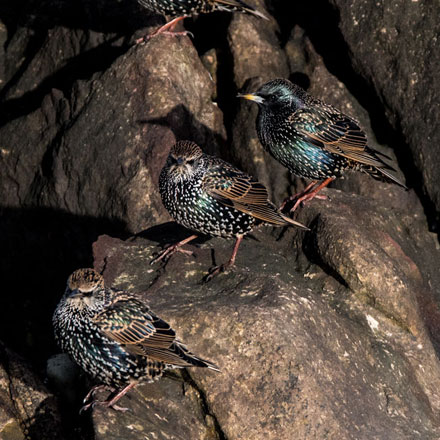 |
| Eider |
Curlew |
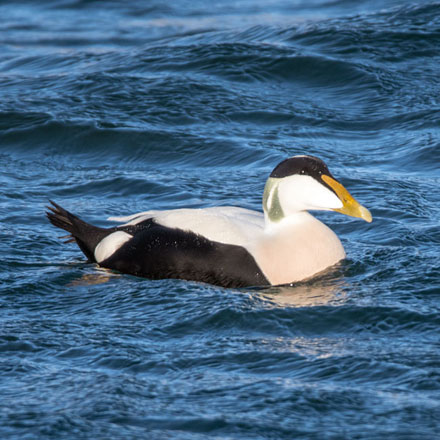 |
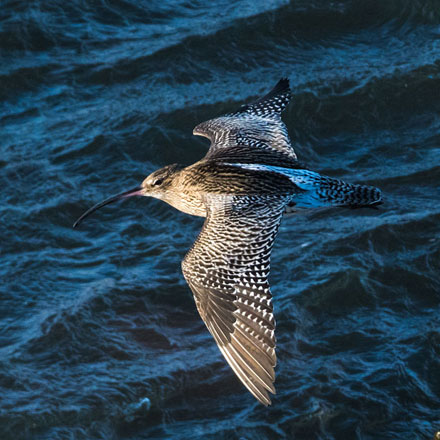 |
1st
December 2019: Gourock
and Fairlie
Cold, dry and bright weather was predicted for Scotland, but in the
Central Belt that was to be after early-morning mists had lifted. We
headed for Erskine once more, to finish our exploration of the south
side of the Clyde estuary beginning at the Erskine Bridge. However the
mists hadn’t lifted after our usual Morrisons breakfasts
(9/10:
-1 for scented black pudding), so by 11 o’clock we decided to
abandon the Erskine walk and drive west to Gourock
where the mists could have cleared. So when we arrived in Gourock we
were pleased to discover that they had, so we parked in the
Battery Park car park and set forth scanning the
Gourock Bay shoreline. Below is a view north to Kilcreggan that
shows the extent of the mist as we set off.
Our first spot was of a Curlew probing the rocks by the Water Treatment
works. A bonny wee Robin turned up on the path a few metres ahead of us
before flying into the trees in the grounds of the Works. I snapped a
picture of one of the many Oystercatchers we could see, but the
numerous Eiders sited offshore were a bit too far away for a decent
shot. We did see a Greenfinch briefly on a branch of the same tree the
Robin had been in.
| Curlew |
Robin |
Oystercatcher |
Greenfinch |
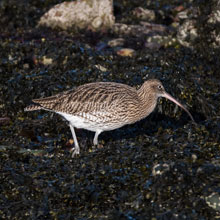 |
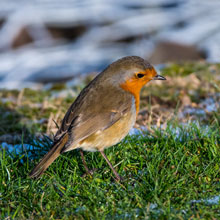 |
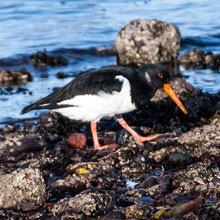 |
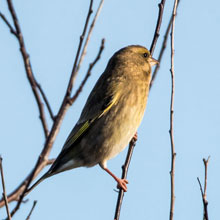 |
We strolled westwards along the prom and saw an Oystercatcher jealously
guarding a shell. A bold second-year Herring Gull stood watching. Far
away on the rocks there were a few Ringed Plovers and even more distant
Turnstones. A Curlew flew in and settled further to the east.
| Oystercatcher |
2nd Cycle Herring Gull |
Ringed Plover |
Curlew |
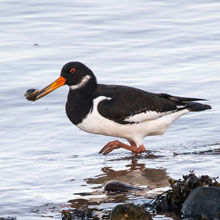 |
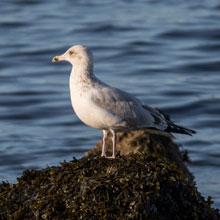 |
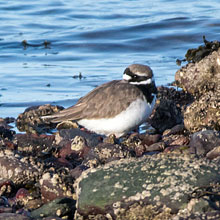 |
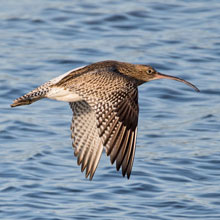 |
The view of Gourock Harbour with Dunoon beyond, taken from Battery Park:
A dog was cavorting on the part of the shore closest to the main road.
Just beyond it a pair of Mute Swans went about their business
relatively unconcerned, as did a small group of Redshanks and a mature
Herring Gull.
|
Mute Swan |
Redshank |
Herring Gull |
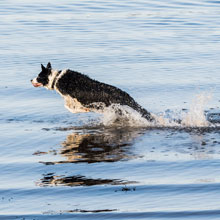 |
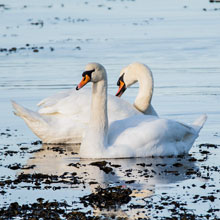 |
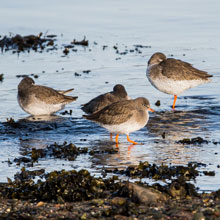 |
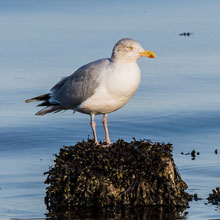 |
We passed into Cove Road
where I caught a shot of a Curlew in flight,
carrying a Crab. A few elusive Goldfinches were twittering in the
roadside trees, but eventually I managed a passable shot. In the Bay we
saw a dozen or so fairly close Eiders diving for Sea
Urchins (see
also “Pictures of the Week”, below). I framed a
handsome
Black-headed Gull as it posed on the railings, a much underrated
species I’ve alway thought.
| Curlew |
Goldfinch |
Eider |
Black - headed Gull |
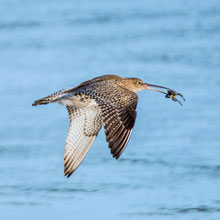 |
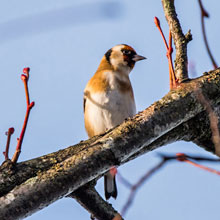 |
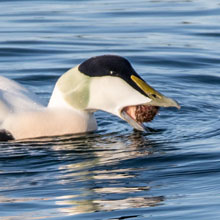 |
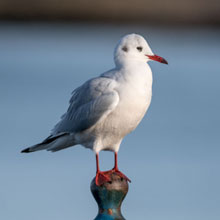 |
We returned to the car
having decided to drive south, past Largs to Fairlie . Just before we left, four Eider flew past,
already heading in that direction.
At Fairlie the low sun
bathed the village in amber light.
We were parked at the
car park to the south of the village. It is a
great vantage point for views of passing birds as well as birds feeding
in the bay and rocky shoreline. On arrival there was a flock of about 50
Wigeon
on the shore. Offshore a few Red-breasted Mergansers seemed to be
courting. A Common Gull was circling overhead ever-vigilant to any
feeding opportunity that presented itself. Occasionally passing
pedestrians unwittingly scared some of the wary Wigeon to take to
temporarily to the water.
| Wigeon |
Red - breasted Merganser |
Common Gull |
Wigeon |
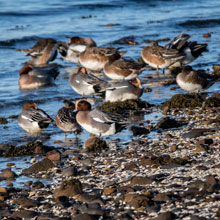 |
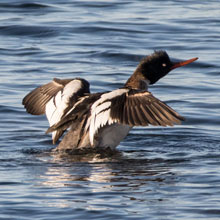 |
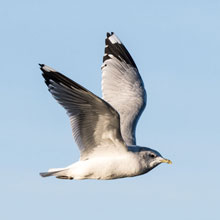 |
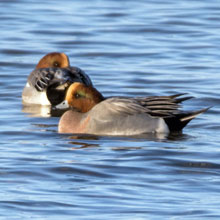 |
As we walked across the
small bridge over the Fairlie Burn, a Dipper darted past and settled on a small midstream rock. I slowly manoeuvred
myself into a good position for a picture and I was surprised the bird
let me get quite close (see also “Pictures of the
Week”, below). We both noticed a wee brown bird preening on a
small tree by the shore. It was a shabby-looking, but very
accommodating Dunnock .
We planked ourselves on a bench that was partially hidden from the
shore and was also beside more small trees that we’d seen
perching birds. Before too long a few Starling swooped down onto
seaweed piled on the sand. Also a female Hedge Sparrow landed briefly on
the nearest tree, before it too went down to the seaweed.
| Dipper |
Dunnock |
Starling |
Female House Sparrow |
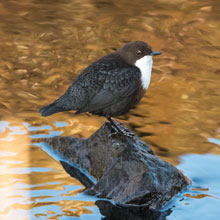 |
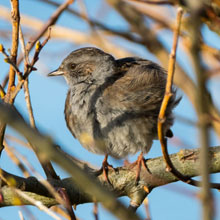 |
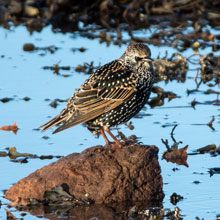 |
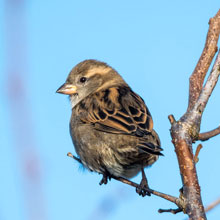 |
Three Goldfinches then
landed on the tree and provided a very welcome
photo-opportunity (see also “Pictures of the Week”,
below).
They are very photogenic, being brightly coloured, and the light being
so warm. As we walked back to the car, a big Carrion Crow flew onto the
grass with a slice of bread in its beak, which it quickly dispatched.
In the water, as the sun lowered in the sky, the birds were becoming
orange - as can be seen in the photos of the female Red-breasted
Merganser and drake Teal Time for tea.
| Goldfinch |
Carrion Crow |
Red - breasted Merganser |
Teal |
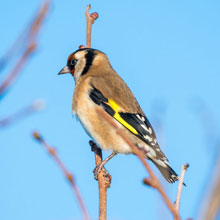 |
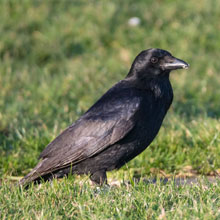 |
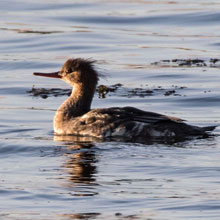 |
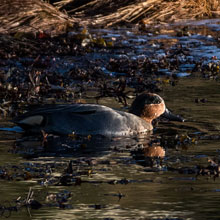 |
So after an uncertain
start the outing became rather enjoyable. The
Clyde Coast is certainly a very beautiful place in sunny weather. We
photographed a lovely selection of birds, my favourites being the
Eiders, Dipper and Goldfinch (see below). So before the picturesque
backdrop of the island of Great Cumbrae (known to many as Millport), we
had our usual teas with cream and jam muffins. A delicious end to a
scrumptious day (or should that be the other way round?).
Pictures of the Week:
| Male Eider |
Female Eider |
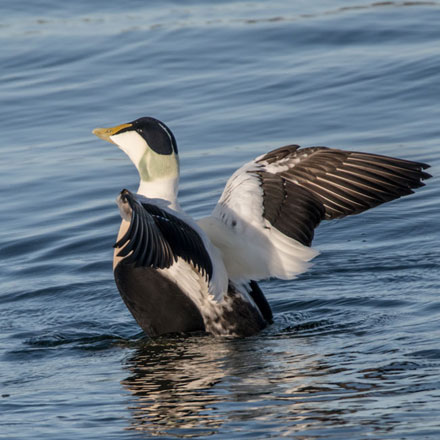 |
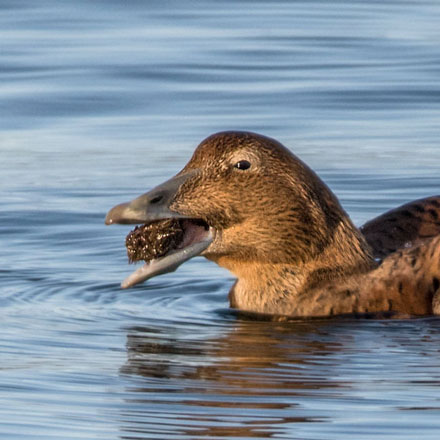 |
| Dipper |
Goldfinch |
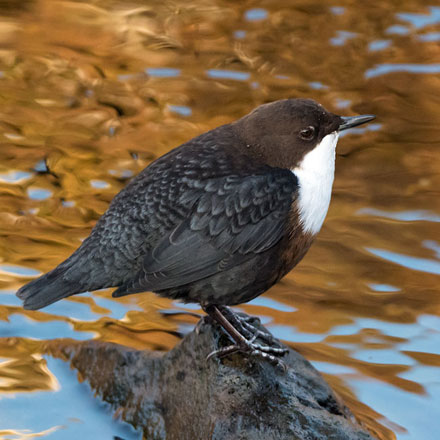 |
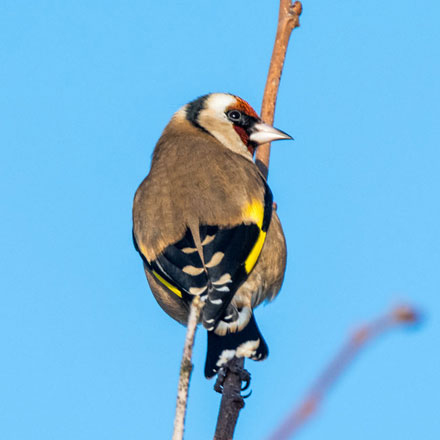 |
Highlights
- December 2019
Here’s the
last gallery of my
favourite pictures of 2019, taken during December. Once again they are
in loose sets of themes and not in the order they have been taken.
WINGS
| Curlew |
Lapwing |
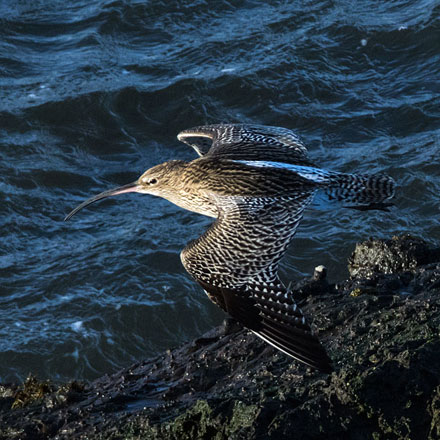 |
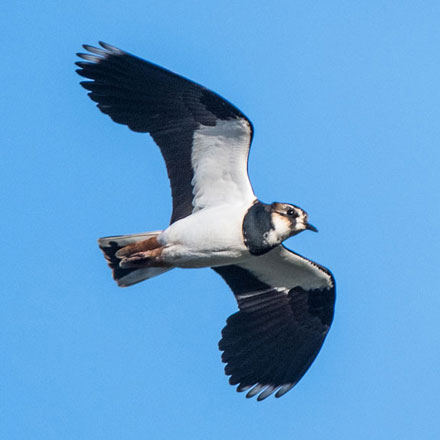 |
| Moorhen |
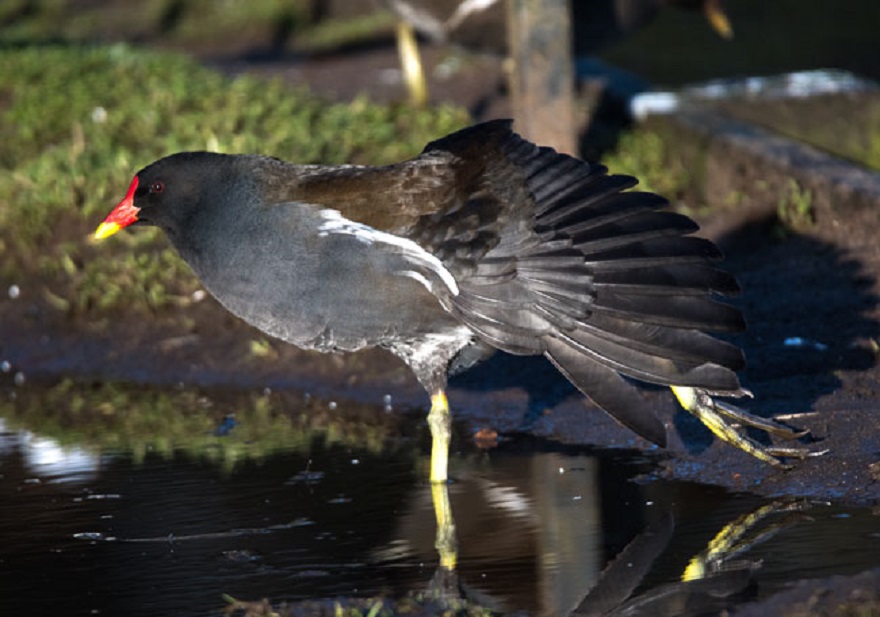 |
| Black - headed Gull |
Common
Gull |
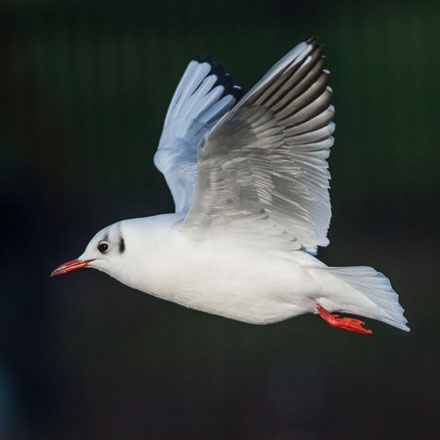 |
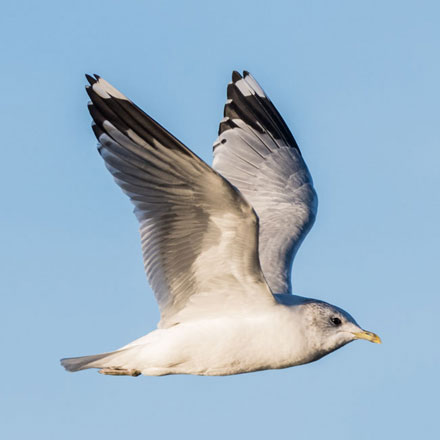 |
| Mallard |
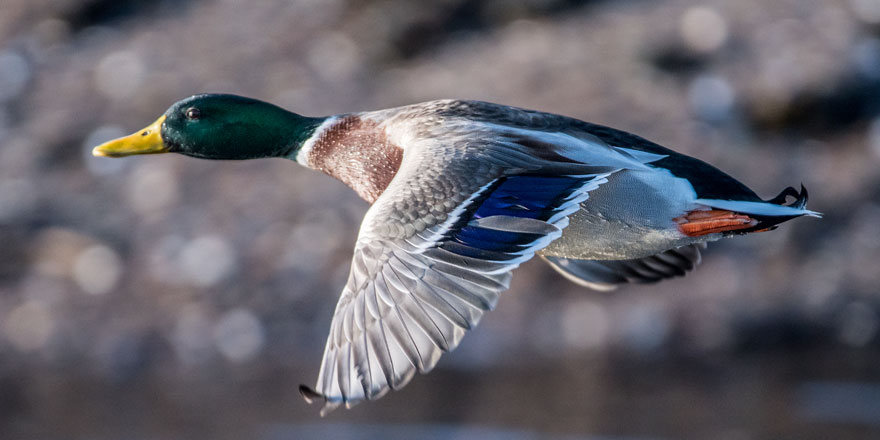 |
SWANS
| Whooper / Mute Swan |
Whooper Swan |
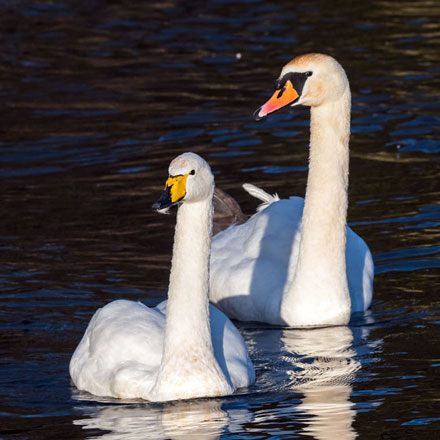 |
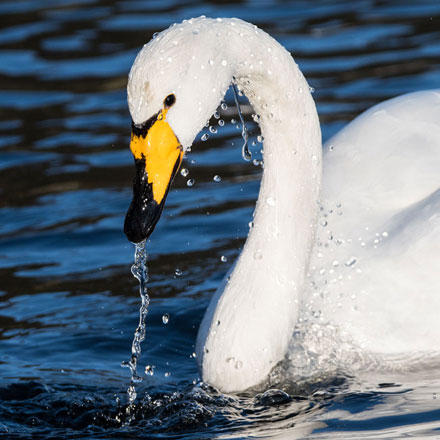 |
| Mute |
Swan |
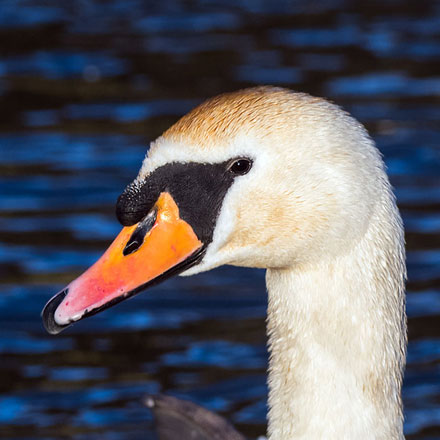 |
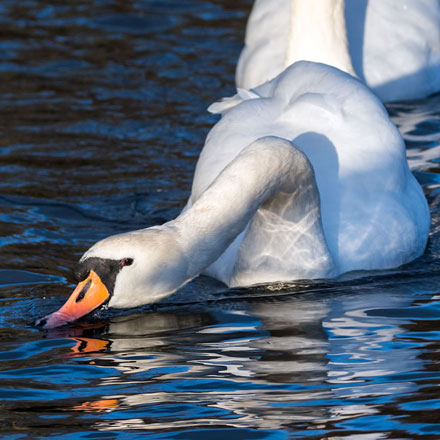 |
| Juvenile
Mute Swan |
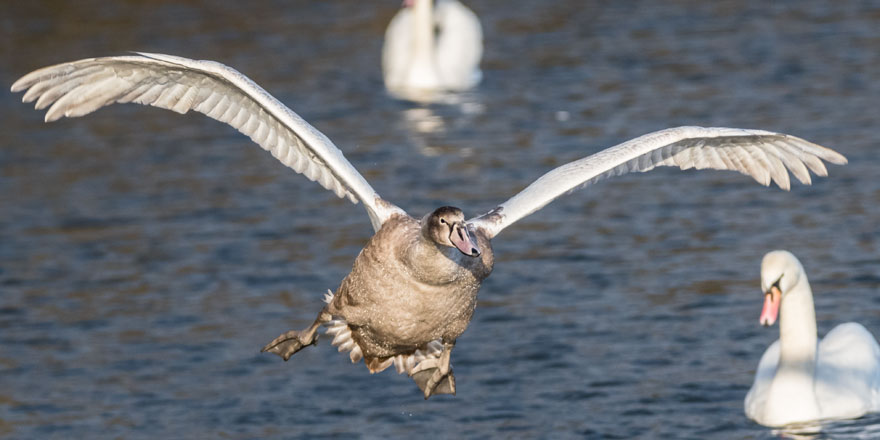 |
PORTRAIT
| Female Goldeneye |
Grey Heron |
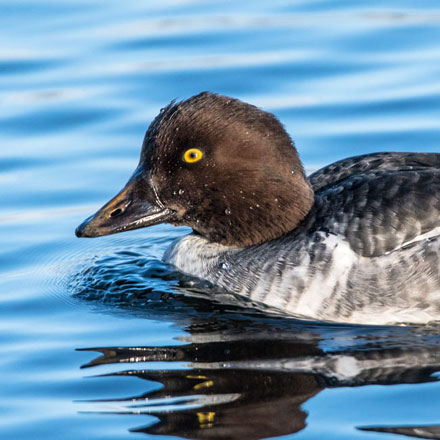 |
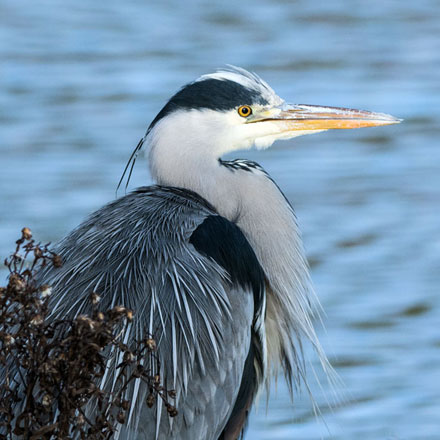 |
| Lesser Black - backed Gull |
Tufted Duck |
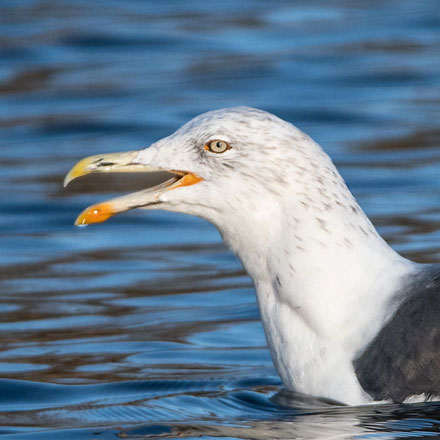 |
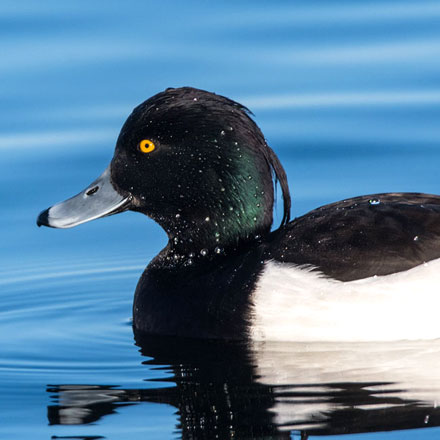 |
MIXED BAG
| Greylag Goose |
Pink - footed Goose |
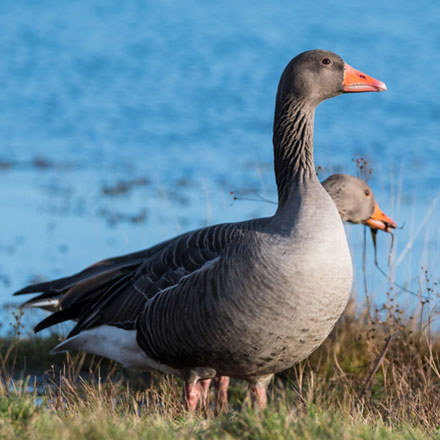 |
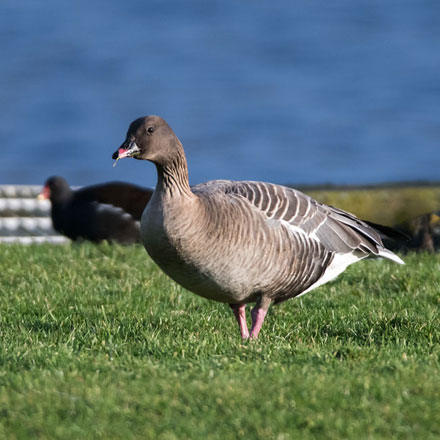 |
| Female Roe Deer |
Eider |
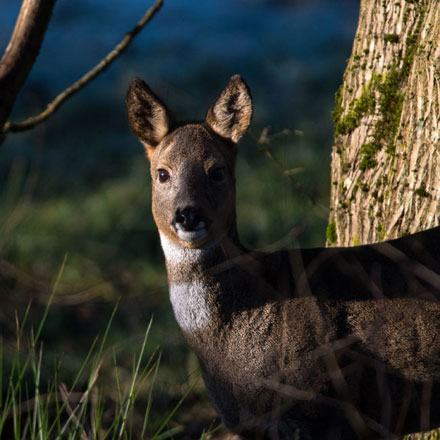 |
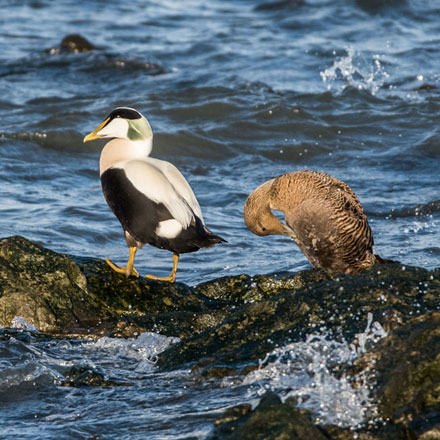 |
| Displaying
Goldeneye |
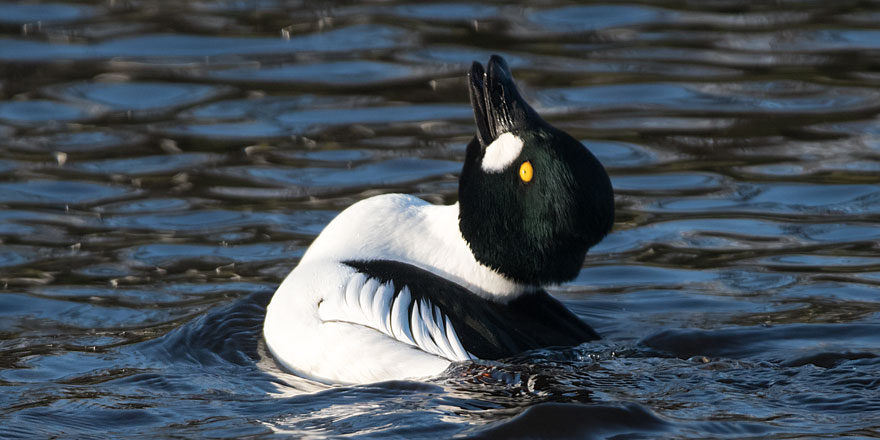 |
SHORE BIRDS
| Curlew |
Red - throated Diver |
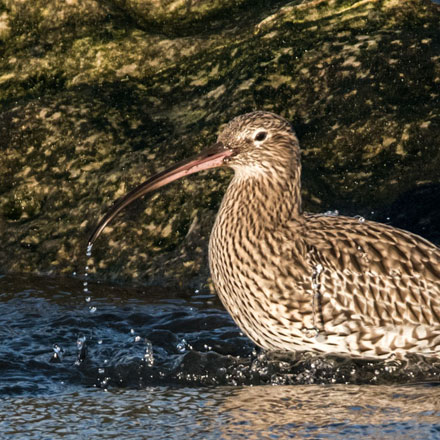 |
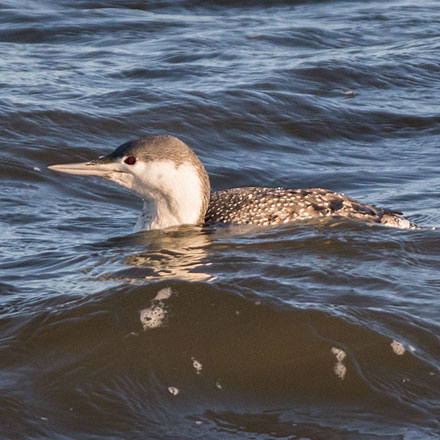 |
| Redshank |
Turnstone |
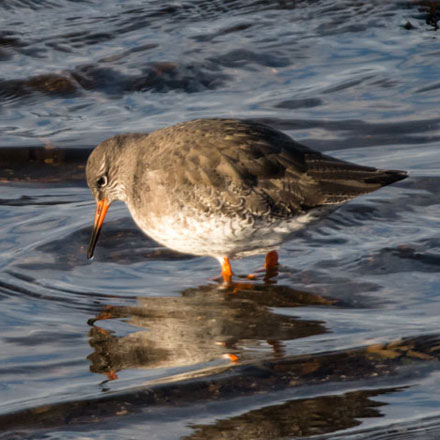 |
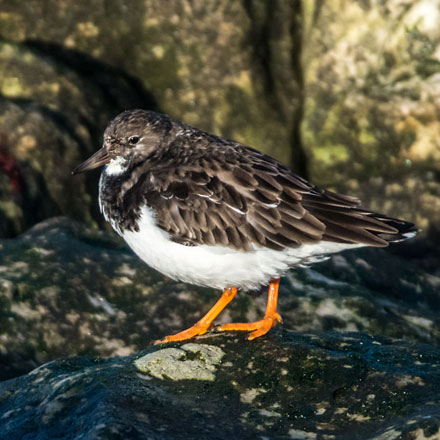 |
FEEDERS
| Goldfinch |
Oystercatcher |
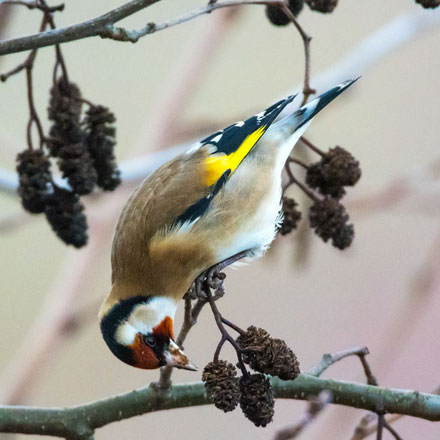 |
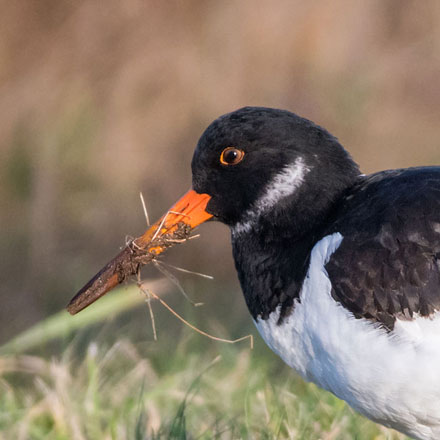 |
| Female Siskin |
Male Siskin |
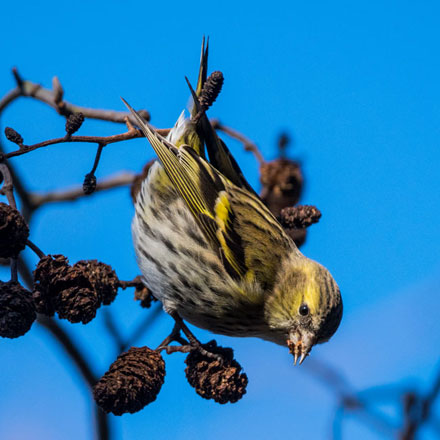 |
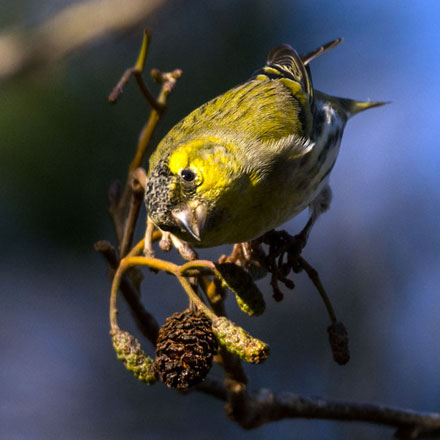 |
PARK BIRDS
| Fieldfare |
Mistle Thrush |
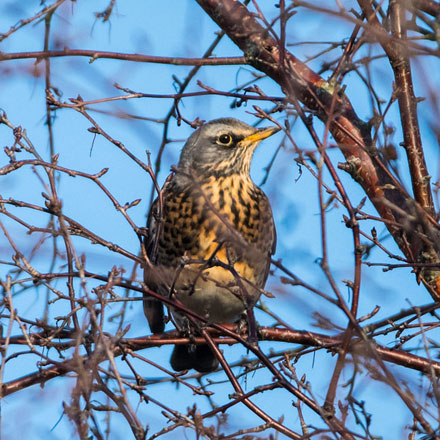 |
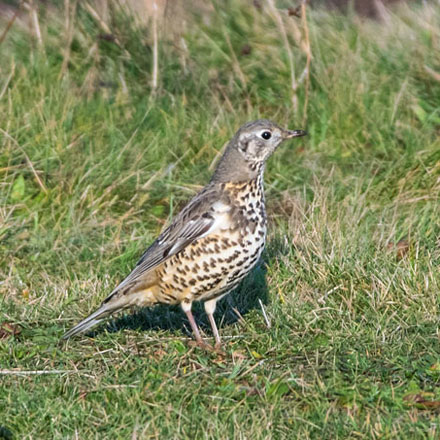 |
| Moorhen |
Redwing |
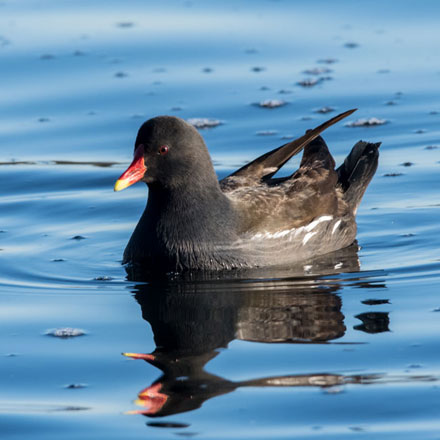 |
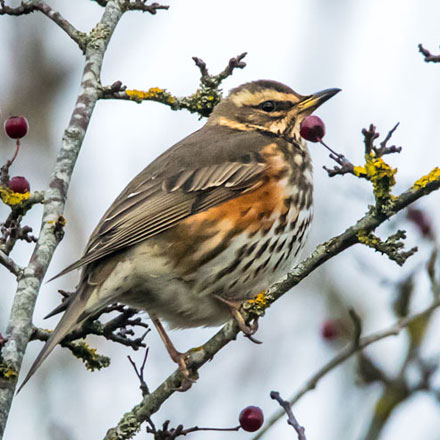 |
| Robin |
Female Tufted Duck |
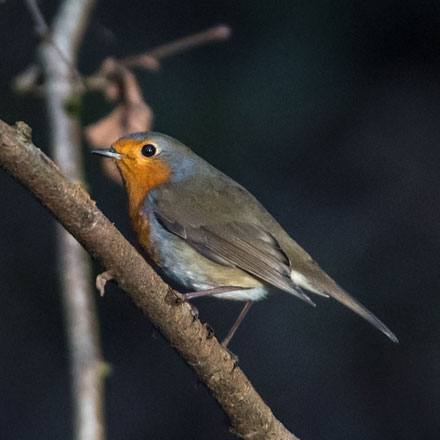 |
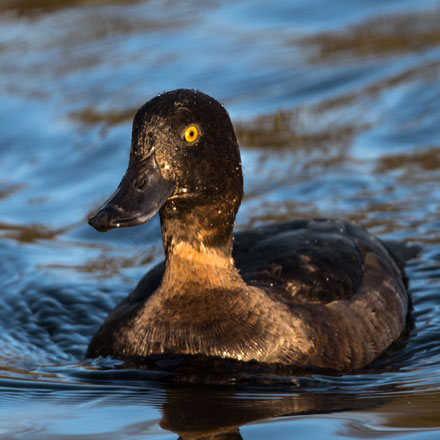 |
| Male
Goosander |
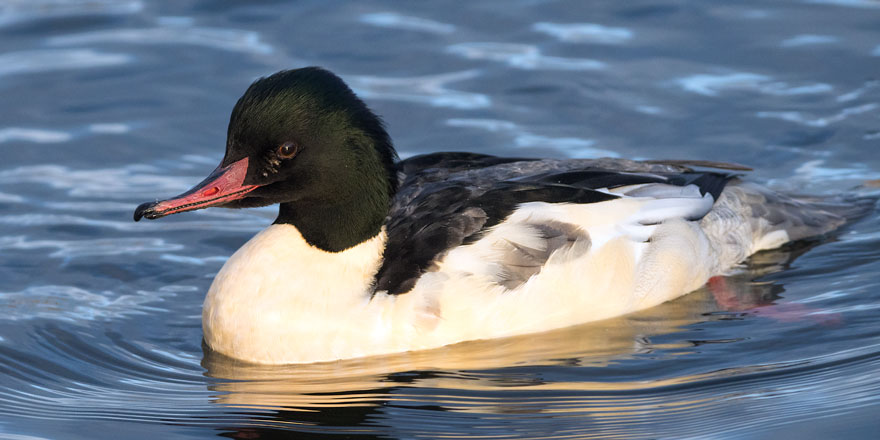 |
Back To Top
|

